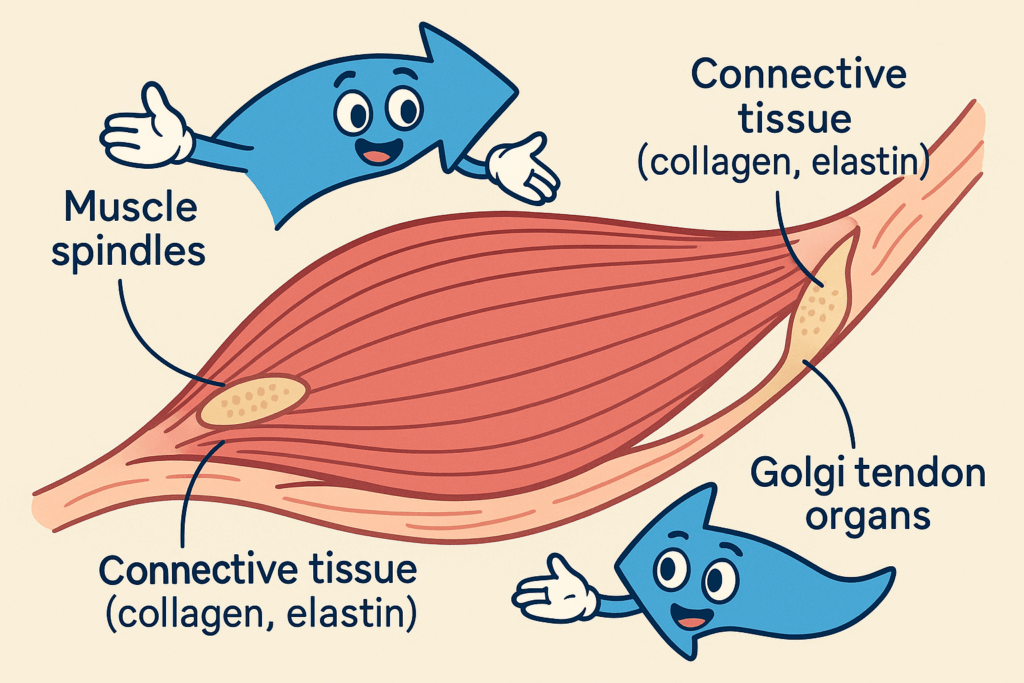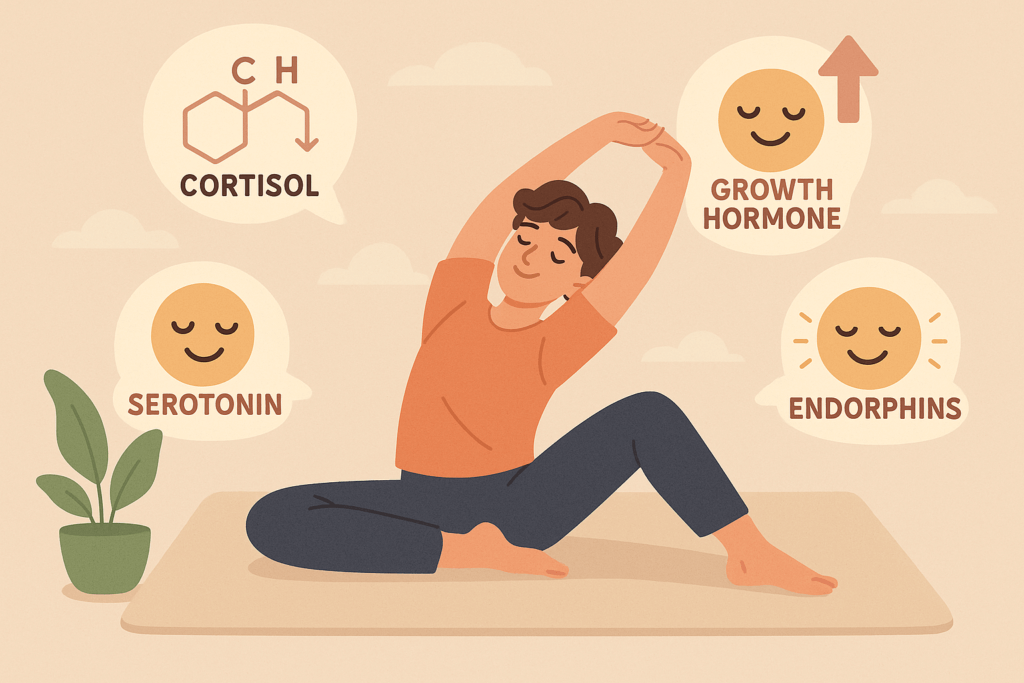Most people treat stretching as an afterthought—something you do quickly before or after a workout. But stretching is much more than loosening tight muscles. It actually reshapes your connective tissues, recalibrates your nervous system, and even changes your hormonal environment. The science of stretching reveals that flexibility is not just about touching your toes—it’s about boosting circulation, preventing injury, reducing stress, and even slowing the aging process.
When you stretch, your body activates sensors in muscles and tendons, releases molecules like nitric oxide (NO) for blood flow, and stimulates collagen remodeling in connective tissues. These biochemical changes explain why flexibility training improves performance, posture, and even longevity.
Let’s dive into the real science of stretching—and why it matters more than you might think.
The Physiology of Stretching
Stretching is both mechanical and neurological:
- Mechanical Response
- Muscles contain fibers made of actin and myosin. Stretching lengthens these fibers and rearranges elastin and collagen in connective tissue.
- Collagen is stiff by nature, but repeated stretching stimulates fibroblasts (cells that build collagen) to remodel fibers, making tendons and fascia more pliable.
- Neurological Response
- Specialized sensors called muscle spindles detect stretching and resist sudden lengthening to prevent injury.
- Golgi tendon organs sense tension in tendons and signal muscles to relax when stress is too high.
- With practice, your nervous system adapts, reducing resistance and allowing greater range of motion.

This dual process is why stretching improves flexibility over time—your tissues adapt, and your nervous system “trusts” the movement.
Stretching and Hormones
Stretching influences your endocrine system in fascinating ways:
- Cortisol: Stretching lowers this stress hormone by activating the parasympathetic nervous system.
- Endorphins: Longer stretches release endorphins, natural painkillers that also create a sense of calm.
- Growth Hormone: Stretching before sleep can improve sleep depth, enhancing nocturnal growth hormone pulses.
- Serotonin: Stretching promotes serotonin release, stabilizing mood and helping regulate the sleep-wake cycle.
That’s why a deep stretching session before bed often feels as rejuvenating as meditation.
Nitric Oxide and Circulation
One of the most overlooked effects of stretching is the release of nitric oxide (NO). When tissues are stretched, endothelial cells in blood vessels release NO, which dilates arteries, improves oxygen delivery, and reduces blood pressure.
This is why dynamic stretching before exercise improves performance—muscles are literally receiving more oxygen and nutrients due to nitric oxide’s vasodilation effect.

Why Flexibility Matters for Performance
Flexibility is not about looking graceful—it directly impacts strength, efficiency, and power:
- Length-Tension Relationship: Muscles generate maximum power at an optimal length. Stretching helps maintain this balance.
- Posture & Alignment: Flexible hip flexors and hamstrings prevent back pain and improve squat form.
- Injury Prevention: Flexible joints distribute loads evenly, reducing ligament and tendon strain.
- Athletic Gains: Sprinters, dancers, and fighters rely on elasticity for explosive performance.
Flexibility is the silent partner of strength—it unlocks performance potential you may not even know you have.
Types of Stretching and Their Effects
1. Static Stretching
- Holding a position for 20–60 seconds.
- Increases tolerance of muscle lengthening by training nervous system to relax.
- Best after workouts for reducing muscle tone and calming cortisol.
2. Dynamic Stretching
- Controlled movements like leg swings or arm circles.
- Increases blood flow and nitric oxide release.
- Ideal for warm-ups to prepare muscles for explosive work.
3. PNF (Proprioceptive Neuromuscular Facilitation)
- Involves contracting and relaxing a muscle during a stretch.
- Maximizes flexibility by manipulating muscle spindle and Golgi tendon organ reflexes.
- Often used in physiotherapy.
4. Ballistic Stretching
- Bouncing movements to push beyond normal range.
- Increases muscle spindle activation but carries higher injury risk.
- Used by athletes needing extreme flexibility (gymnasts, martial artists).

Stretching and Aging
As we age, collagen stiffens and elastin fibers degrade, leading to reduced mobility. Stretching directly combats this process by stimulating fibroblasts to remodel collagen.
Older adults who stretch regularly maintain:
- Better circulation (thanks to nitric oxide).
- Lower risk of falls (due to joint mobility).
- Stronger postural muscles (reducing spinal curvature).
Flexibility is literally a marker of biological youth.
Fitness Myths You Need to Stop Believing Right Now
Stretching for Stress Relief and Mental Health
Stretching does more than improve muscles—it calms the mind.
- Parasympathetic Activation: Deep stretches activate the vagus nerve, lowering heart rate and cortisol.
- Neurochemical Balance: Serotonin and endorphins rise, creating a natural antidepressant effect.
- Brain Function: Regular stretching improves cerebral blood flow, supporting memory and focus.

This explains why yoga, which is built around stretching and breath control, has profound mental health benefits.
Common Stretching Mistakes
- Stretching Cold Muscles: Always warm up first; cold muscles are less pliable.
- Overstretching: Can cause microtears and joint instability.
- Holding Breath: Reduces oxygen and nitric oxide release.
- Ignoring Symmetry: Only stretching one side creates imbalances.
Side Effects and Precautions
- Overstretching joints can cause laxity and injuries.
- Ballistic stretching should be done only with supervision.
- People with connective tissue disorders (like Ehlers-Danlos) should avoid extreme stretches.
FAQs
1. Does stretching make you taller?
No, but it improves posture, which can make you appear taller.
2. Is stretching better before or after a workout?
Dynamic before, static after.
3. Can stretching increase muscle strength?
Indirectly—by improving the muscle’s ability to contract efficiently.
4. How long does it take to improve flexibility?
Most people see improvements in 4–6 weeks with consistent stretching.
5. Can stretching reduce stress?
Yes. It lowers cortisol and boosts serotonin and endorphins.
Disclaimer
This article is for informational purposes only and is not a substitute for professional medical advice, diagnosis, or treatment. We are not doctors. Always consult your physician or a qualified healthcare provider with any questions you may have regarding a medical condition. Do not rely on online content alone to make decisions about your health.
